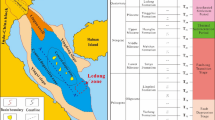Abstract
The formation pressure system of Yinggehai Basin has the characteristics of poor horizontal distribution regularity and severe vertical distribution changes. This paper proposes a new method for predicting the horizontal and vertical distribution trend of formation pressure for the situation of limited offshore drilling data. The method is based on the topological triangulation algorithm, combined with the data set to fit the multivariate interpolation function, and conveniently realizes the prediction and visualization of the three-dimensional horizontal and vertical distribution trend of regional formation pressure. On this basis, through the analysis of the relevant data of the complex accident points that have been drilled, the characteristics of the single well safety density window and the regional safety density window are clarified. The study found that there is no high pressure in the shallow layer of the block, and the formation pressure spreads smoothly in the lateral direction; the high pressure top surface is at 3500 m, and the formation pressure gradually increases with the increase in longitude and decrease in latitude in the lateral direction. The formation pressure rises extremely rapidly with the increase of depth in the longitudinal direction, which has the characteristic of “broken line pressurization”. The safety density window of single well is in the shape of funnel with the characteristic of turning back, and the turning section is between 3500 and 4000 m. The safety density window feature of the block can be divided into three stages according to the depth, and the window appears extremely narrow after 3500 m (< 0.3 g/cm3).
Access this chapter
Tax calculation will be finalised at checkout
Purchases are for personal use only
Similar content being viewed by others
References
Liang, H., Guo, S., Liao, G.: Application of pressure-monitoring technology while drilling in non-undercompaction overpressure formation in Ledong area of Yingqiong basin. Chin. Offshore Oil Gas 32(04), 147–151 (2020)
Fan, C.: The identification and characteristics of migration system induced by high pressure, and its hydrocarbon accumulation process in the Yingqiong Basin. Oil Gas Geol. 39(02), 254–267 (2018)
Liu, A., Zhou, J., Fan, C., et al.: Pre-drilling pressure prediction problems and solutions in the HTHP strata of the Yinggehai-Qiongdongnan Basin. Nat. Gas. Ind. 35(02), 21–26 (2015)
Li, Y., Ai, C., et al.: Analysis on influential factors for safe window of drilling fluid density in deep well. Petrol. Geol. Recovery Effi. 20(01), 107–110 (2013)
Qin, S., Hou, X.: Research on drilling design techniques for narrow mud weight window. Petrol. Drill. Tech. 39(03), 62–65 (2011)
Li, W., Li, Z., Liu, B., et al.: The status quo and prospects for pore pressure prediction technology in Yingqiong Basin of South China Sea. Offshore Oil 40(03), 8–12 (2020)
Luo, M., Jiang, W., Chen, H., et al.: Ultra-High Temperature High Pressure Drilling Technology for Narrow Safety Density Window Strata in the Western South China[J]. PETROLEUM DRILLING TECHNIQUES 47(01), 8–12 (2019)
Liao, M., Yitao, H.: Application of formation pressure monitoring while drilling in D Block, South Sea. Mud Logging Eng. 24(03), 19–25 (2013)
Sun, D., Yang, J., et al.: Application of formation pressure prediction while drilling technology in HTHP wells. Oil Drill. Prod. Technol. 38(06), 746–751 (2016)
**e, Y.: Application of formation pressure prediction while drilling technology in HTHP wells. Nat. Gas. Ind. 31(12), 21–25 (2011)
Li, L.: Study and Application of Three-dimensional Delaunay Triangulation Algorithm. Dalian Maritime University (2010)
Acknowledgements
This research work was supported by the Science Foundation of China University of Petroleum, Bei**g (Grant No. 2462020XKBH011), the Key Program of the National Natural Science Foundation of China (Grant No. 51734010), the Scientific Research and Technology Development Project of China National Petroleum Corporation (Number 2020B-4019).
Author information
Authors and Affiliations
Corresponding author
Editor information
Editors and Affiliations
Rights and permissions
Copyright information
© 2024 The Author(s), under exclusive license to Springer Nature Switzerland AG
About this paper
Cite this paper
Gao, R., Cui, Y., Fan, J., Yang, G., Yang, H. (2024). Prediction of Horizontal and Vertical Distribution Trend of Formation Pressure and Characteristics of Safety Density Window in Yinggehai Basin. In: Li, S. (eds) Computational and Experimental Simulations in Engineering. ICCES 2023. Mechanisms and Machine Science, vol 145. Springer, Cham. https://doi.org/10.1007/978-3-031-42987-3_48
Download citation
DOI: https://doi.org/10.1007/978-3-031-42987-3_48
Published:
Publisher Name: Springer, Cham
Print ISBN: 978-3-031-42986-6
Online ISBN: 978-3-031-42987-3
eBook Packages: EngineeringEngineering (R0)




